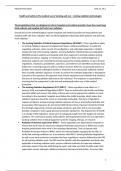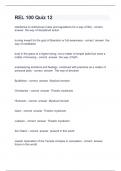Essay
Unit 21 LA:C (Health and safety in the medical use of ionising and non – ionising radiation technologies)
- Institution
- PEARSON (PEARSON)
This assignment has achieved DISTINCTION grade and contains all of the necessary contents such as legislation for using on ionising techniques and non -ionising techniques, ranking the medical instruments from most dangerous to least dangerous. This assignment was written in high quality to ensure ...
[Show more]





